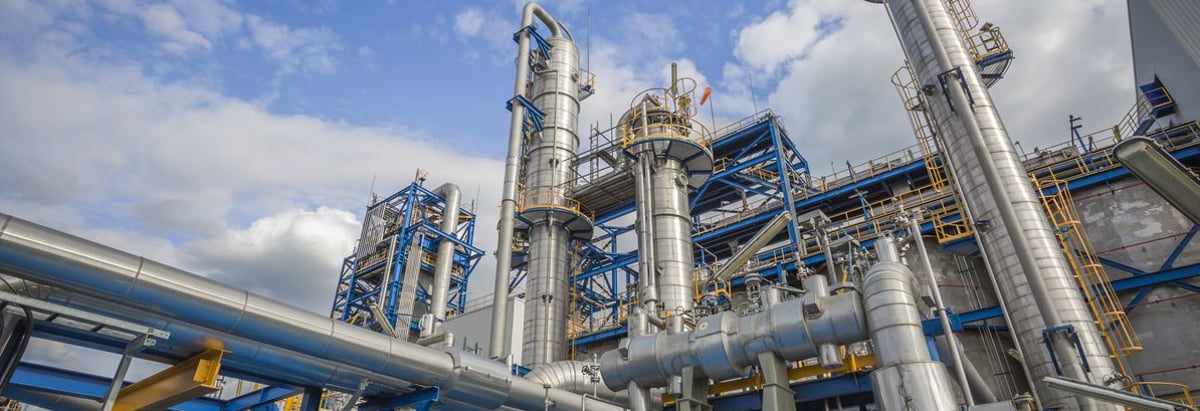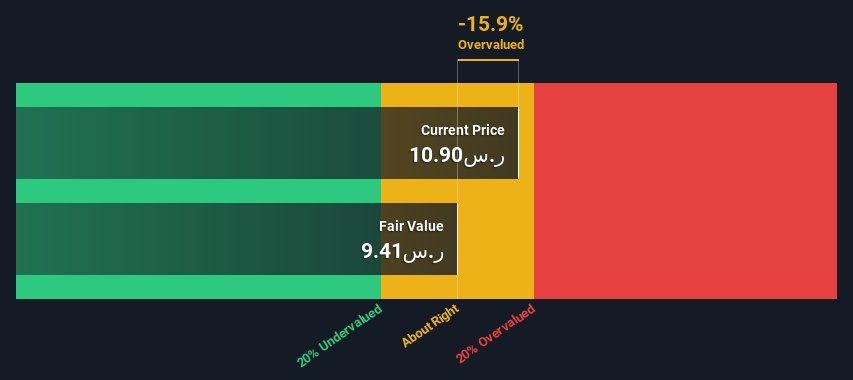- Saudi Arabia
- /
- Oil and Gas
- /
- SASE:2380
Estimating The Intrinsic Value Of Rabigh Refining and Petrochemical Company (TADAWUL:2380)

Key Insights
- The projected fair value for Rabigh Refining and Petrochemical is ر.س9.41 based on 2 Stage Free Cash Flow to Equity
- Current share price of ر.س10.90 suggests Rabigh Refining and Petrochemical is potentially trading close to its fair value
- Analyst price target for 2380 is ر.س10.80, which is 15% above our fair value estimate
Today we will run through one way of estimating the intrinsic value of Rabigh Refining and Petrochemical Company (TADAWUL:2380) by taking the expected future cash flows and discounting them to their present value. One way to achieve this is by employing the Discounted Cash Flow (DCF) model. Models like these may appear beyond the comprehension of a lay person, but they're fairly easy to follow.
We would caution that there are many ways of valuing a company and, like the DCF, each technique has advantages and disadvantages in certain scenarios. If you still have some burning questions about this type of valuation, take a look at the Simply Wall St analysis model.
Check out our latest analysis for Rabigh Refining and Petrochemical
The Model
We're using the 2-stage growth model, which simply means we take in account two stages of company's growth. In the initial period the company may have a higher growth rate and the second stage is usually assumed to have a stable growth rate. In the first stage we need to estimate the cash flows to the business over the next ten years. Where possible we use analyst estimates, but when these aren't available we extrapolate the previous free cash flow (FCF) from the last estimate or reported value. We assume companies with shrinking free cash flow will slow their rate of shrinkage, and that companies with growing free cash flow will see their growth rate slow, over this period. We do this to reflect that growth tends to slow more in the early years than it does in later years.
Generally we assume that a dollar today is more valuable than a dollar in the future, so we need to discount the sum of these future cash flows to arrive at a present value estimate:
10-year free cash flow (FCF) forecast
| 2023 | 2024 | 2025 | 2026 | 2027 | 2028 | 2029 | 2030 | 2031 | 2032 | |
| Levered FCF (SAR, Millions) | ر.س3.36b | ر.س2.84b | ر.س2.92b | ر.س3.03b | ر.س3.05b | ر.س3.15b | ر.س3.30b | ر.س3.50b | ر.س3.74b | ر.س4.02b |
| Growth Rate Estimate Source | Analyst x2 | Analyst x1 | Analyst x1 | Analyst x1 | Est @ 0.61% | Est @ 3.10% | Est @ 4.85% | Est @ 6.07% | Est @ 6.93% | Est @ 7.52% |
| Present Value (SAR, Millions) Discounted @ 23% | ر.س2.7k | ر.س1.9k | ر.س1.6k | ر.س1.3k | ر.س1.1k | ر.س898 | ر.س764 | ر.س658 | ر.س571 | ر.س498 |
("Est" = FCF growth rate estimated by Simply Wall St)
Present Value of 10-year Cash Flow (PVCF) = ر.س12b
After calculating the present value of future cash flows in the initial 10-year period, we need to calculate the Terminal Value, which accounts for all future cash flows beyond the first stage. The Gordon Growth formula is used to calculate Terminal Value at a future annual growth rate equal to the 5-year average of the 10-year government bond yield of 8.9%. We discount the terminal cash flows to today's value at a cost of equity of 23%.
Terminal Value (TV)= FCF2032 × (1 + g) ÷ (r – g) = ر.س4.0b× (1 + 8.9%) ÷ (23%– 8.9%) = ر.س31b
Present Value of Terminal Value (PVTV)= TV / (1 + r)10= ر.س31b÷ ( 1 + 23%)10= ر.س3.8b
The total value, or equity value, is then the sum of the present value of the future cash flows, which in this case is ر.س16b. To get the intrinsic value per share, we divide this by the total number of shares outstanding. Compared to the current share price of ر.س10.9, the company appears around fair value at the time of writing. Remember though, that this is just an approximate valuation, and like any complex formula - garbage in, garbage out.

Important Assumptions
The calculation above is very dependent on two assumptions. The first is the discount rate and the other is the cash flows. You don't have to agree with these inputs, I recommend redoing the calculations yourself and playing with them. The DCF also does not consider the possible cyclicality of an industry, or a company's future capital requirements, so it does not give a full picture of a company's potential performance. Given that we are looking at Rabigh Refining and Petrochemical as potential shareholders, the cost of equity is used as the discount rate, rather than the cost of capital (or weighted average cost of capital, WACC) which accounts for debt. In this calculation we've used 23%, which is based on a levered beta of 2.000. Beta is a measure of a stock's volatility, compared to the market as a whole. We get our beta from the industry average beta of globally comparable companies, with an imposed limit between 0.8 and 2.0, which is a reasonable range for a stable business.
SWOT Analysis for Rabigh Refining and Petrochemical
- Debt is well covered by cash flow.
- Earnings declined over the past year.
- Interest payments on debt are not well covered.
- Shareholders have been diluted in the past year.
- Annual earnings are forecast to grow faster than the Saudi market.
- Good value based on P/E ratio compared to estimated Fair P/E ratio.
- Annual revenue is expected to decline over the next 3 years.
Next Steps:
Valuation is only one side of the coin in terms of building your investment thesis, and it is only one of many factors that you need to assess for a company. The DCF model is not a perfect stock valuation tool. Rather it should be seen as a guide to "what assumptions need to be true for this stock to be under/overvalued?" For example, changes in the company's cost of equity or the risk free rate can significantly impact the valuation. For Rabigh Refining and Petrochemical, there are three pertinent factors you should further examine:
- Risks: Take risks, for example - Rabigh Refining and Petrochemical has 3 warning signs (and 2 which are a bit concerning) we think you should know about.
- Future Earnings: How does 2380's growth rate compare to its peers and the wider market? Dig deeper into the analyst consensus number for the upcoming years by interacting with our free analyst growth expectation chart.
- Other High Quality Alternatives: Do you like a good all-rounder? Explore our interactive list of high quality stocks to get an idea of what else is out there you may be missing!
PS. Simply Wall St updates its DCF calculation for every Saudi stock every day, so if you want to find the intrinsic value of any other stock just search here.
If you're looking to trade Rabigh Refining and Petrochemical, open an account with the lowest-cost platform trusted by professionals, Interactive Brokers.
With clients in over 200 countries and territories, and access to 160 markets, IBKR lets you trade stocks, options, futures, forex, bonds and funds from a single integrated account.
Enjoy no hidden fees, no account minimums, and FX conversion rates as low as 0.03%, far better than what most brokers offer.
Sponsored ContentNew: AI Stock Screener & Alerts
Our new AI Stock Screener scans the market every day to uncover opportunities.
• Dividend Powerhouses (3%+ Yield)
• Undervalued Small Caps with Insider Buying
• High growth Tech and AI Companies
Or build your own from over 50 metrics.
Have feedback on this article? Concerned about the content? Get in touch with us directly. Alternatively, email editorial-team (at) simplywallst.com.
This article by Simply Wall St is general in nature. We provide commentary based on historical data and analyst forecasts only using an unbiased methodology and our articles are not intended to be financial advice. It does not constitute a recommendation to buy or sell any stock, and does not take account of your objectives, or your financial situation. We aim to bring you long-term focused analysis driven by fundamental data. Note that our analysis may not factor in the latest price-sensitive company announcements or qualitative material. Simply Wall St has no position in any stocks mentioned.
About SASE:2380
Rabigh Refining and Petrochemical
Engages in the development, construction, and operation of an integrated refining and petrochemical complex in the Middle East, the Asia Pacific, and internationally.
Fair value with mediocre balance sheet.
Market Insights
Community Narratives



